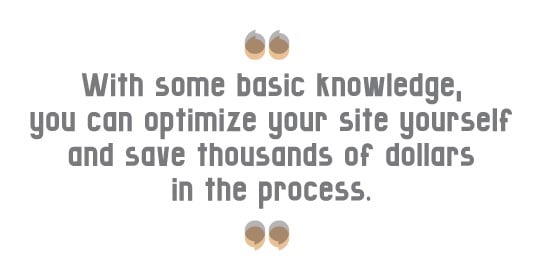
In search of practical and actionable local SEO tips for your site? In this second part of our SEO Agency Experts series, we’ve assembled another group of experienced professionals with diverse backgrounds in SEO and online marketing to reveal to you some of their best tips on local SEO. From directory listings and backlinks to content creation, we have the answers you’ve been looking for – from 12 of the industry’s most trusted sources. Go forth and optimize.
1. “Outreach to influencers – who can provide high authority backlinks – and good content build real SEO value into your website.”
“Relationship building tactics, like social influencer outreach, are vital for SEO. When you have a lot of people sharing your content, that’s great. But it’s even better when you have one key market influencer sharing your content with their entire network. Plus, when you’re able to get your content blogged about or posted on an influencer’s blog or website, it leads to better quality backlinks to your content from sites with higher domain authority.
I also recommend developing content that’s enriched by other media, like photos and videos. Posts that are enriched generally produce higher rankings and are shared more often.
If you’re not sure where to start with content, take a crowdsourcing approach. Reach out to business team members and website users and ask for help with information, on an idea, or on producing content.”
– Daniel Snell of Evometa
2. “Improve your business’s local ranking by using Google My Business.”
“A Google My Business profile is important for effective local SEO. Not only is it free, but it also boosts your chances of appearing in local search engine results related to your business. So make sure your company information on Google My Business is correct. It’s especially important to have a phone number listed that’s local and matches the number displayed on your website.
Once you check for accuracy, then go ahead and publish the same information across online local directories. If you find a directory with inconsistent information about your company, then claim and correct it. Be sure to fill out all your submissions completely.”
– Will Paccione of Dotxero
3. “Content is the biggest influence on link acquisition, which in turn impacts rankings.”
“Creating valuable content assets – that are easily linkable – is the single best and most scalable link acquisition strategy. Think articles, blog posts, videos, press releases and social media content. But link outreach conversion rates are much higher when you are pitching powerful content assets. And when you create a great asset with information that engages your target audience, it will begin to attract links naturally once it gains some visibility. These links then build up a page’s authority and improve its SEO.”
– Nathan Gotch of Gotchseo
4. “Verification of your listing on Google My Business is the most significant aspect of localized SEO.”
“The most important aspect of localized SEO today is the creation and verification of your Google My Business listing. Over the years, this listing has been managed through specific sections of Google, maps, Google Places, Google +, etc. Today, the listing is managed through Google My Business, which allows for the basic verification of business information like name, address, phone and email, hours or operation, pictures and so forth.
Google may already have your business information in the system. But unless that listing is verified by you through a phone call or a postcard, it is not given the same weight with regards to rankings and positioning of the associated website. Google considers the verified business listing and intermingles that information with the subjects and information about the business genre that is displayed on the associated website. Through this combination of information about the things that the business does and the legitimate verification that a business exists at a specific geographic location, your localized rankings are generated.
We have seen situations where there is nearly no on-site localization or SEO presented for a specific area, and nothing but the creation and verification of a Google My Business listing has sent the organic ranking to a number one position for the associated website.”
– Raymond Santopietro of Focus Internet Services
5. “Your site must be built or updated with search engines in mind.”
“Google and other search engines are fairly good at figuring out what your site is about. However, what is usually unclear is which page or post to correctly display on the results page for a specific keyword or phrase. Most websites without any SEO often fail to rank highly in search results.
Another big problem we see is with websites with code that uses the elements incorrectly on pages. For instance, the heading tag is used for style purposes, such as creating a bigger font or putting space in between paragraphs. But search engines give more weight to content within heading elements. So if your site uses the heading tag incorrectly and all the time, it’s like trying to read a book full of headings. How would that look to you?”
– Jim Johnson of Driven Web Services

6. “The more information you give to search engines, the more relevant your site becomes to them.”
“Give as much information as possible to the search engines for better results. If you can’t do it manually, use an SEO plugin like Yoast Local. But get listed in as many local business directories as you can and encourage positive reviews on your social media profiles. Also, use tools like Schema markup to help your website rank better.”
– Scott Carvin of SEO Services Expert
7. “Adding schema markup to your site can improve your SEO, particularly with competitive local campaigns.”
“The most valuable direction we’ve taken in local SEO over the past year is dedicating time to using schema effectively. Schema is simply code you put on your website that helps a search engine increase its understanding of your site and also improves the way your page displays in search results.
When you’re using schema, just make sure you’re utilizing the correct schema type for your local customers that best describes your business – and not just a ‘schema builder tool.’ Really dedicate time and effort into becoming an expert in this area. It can make all the difference for your highly competitive local campaigns.”
– Robert Lane of Buhv Designs
8. “Many small business owners think they need expensive SEO. But with some basic knowledge, they can check and optimize their sites themselves and save a lot of money.”
“I like to compare SEO to car repair. If you have a serious problem with your car, like loss of power steering, you need the expertise of a mechanic. But if you simply need to check your car fluids, then you can learn to do it yourself.
SEO is like that. Not every business requires an expert. This is especially true if you’re a local business in the type of non-competitive niches typically found in smaller towns and markets. With some basic knowledge, you can optimize your site yourself and save thousands of dollars in the process.

For business owners who don’t need extensive SEO, I recommend these five tips:
Ensuring your name, address and phone (NAP) are consistent on your Google My Business listing and all citation websites, like whitepages.com and yellowpages.com. These sites give powerful, relevant backlinks for local businesses – and search engines love them.
Put your NAP on the page you’re trying to rank for (your landing page).
Geotag pictures on this page with the coordinates of your business.
Learn how to use Google Search Console and Analytics. Console checks your site for crawl errors, penalties, and other things you can do to help Google ‘see’ your site better. Analytics can tell you about traffic to your site and visitor behavior on your site. Both are useful, free, and have free online tutorials.
Ask customers to leave reviews on your Google My Business, Yelp, and Facebook business pages, or another popular business listing review page. The aggregate star rating often shows up next to your business listing in the Search Engine Results Page, and can influence potential customers to click on your entry.”
– Brett Calhoun of Hyperion SEO
9. “When done correctly, link building is still the best strategy for getting a properly optimized site over the hump, so to speak, and ranking better.”
“There’s no one thing (or shortcut) that simply makes for great SEO. It’s a cumulative recipe of to-do’s that ultimately make for optimum results.
That said, I’m a pretty big proponent of link building. You hear and read a lot of folks claiming that link building is dead since Google rolled out Panda 1.0 and 2.0. But I think that’s a very misunderstood thing. It’s not that link building is dead; it’s still very much alive. It’s that the ‘any old link’ approach and spammy keyword anchor-text links are dead. And well they should be.
However, there’s still a ton of value in getting fresh new backlinks to your website – if it’s from a quality and diverse portfolio of linking sources. I find that it’s still effective to focus about 5% of your anchor text with actual keyword terms (‘air conditioning repair St. Louis,’ for example) while focusing the other 95% on things more like the name of your business, the URL of your website, and the name of your business and the city you serve grouped together.”
– Marc Bethel of Commonwealth Creative Marketing
10. “Good SEO results are a blend of on-page SEO, social media, content creation and link building.”
“Anyone with an e-commerce business should be focused on a few different areas to ensure that they are maximizing their SEO efforts.
First comes onpage SEO. Use keywords in alt text (images), titles, product descriptions, meta descriptions, and page titles, to name a few areas. Each of these gives you a great opportunity to drive traffic using common words that your customers use. Your website also needs to be mobile friendly and optimized.
Second is social media. You not only need to have a social media strategy, but you must have the right accounts and be actively using them. This includes Instagram, Facebook, and Snapchat/Periscope. And remember, social media isn’t just about promoting and selling your product. It’s about building a relationship with your customers. People buy from those they know and like.
Third, blogging is an excellent way to draw in customers. However, we live in a microwave world. So video blogging with closed captions is the best way to provide content that is easily digested, not to mention it’s an excellent way to rank with SEO. Fresh content should come out at least two times per month (one video, one article).
And finally, invest in link building through guest blogging. When implemented correctly, you will bring in tons of traffic by getting your brand into the hands of bloggers in your industry. Reach out to local bloggers who have big followings. They need content, so doing so can be a win-win for you both.”
– Juanita Brazziel of Grace Digital Marketing Age
11. “Customer reviews can have a serious SEO benefit.”
“We really stress the importance of soliciting product reviews and posting them on your site. Most modern e-commerce systems have this built it. It provides lots of user-created, unique content for individual product landing pages, and by sharing reviews to other sites and social media it can increase the influence of your site. Most importantly, though, good detailed reviews are critical for conversion and sales success.”
– Alex Wolk of Insite Advice

12. “Focus on key areas to the lay the foundation for good SEO – then build on it over time.”
“In my experience, there are a 5 different areas business owners should pay attention to:
Get rel=”canonical” tags right. Too many times I’ve seen issues where that tag is set up incorrectly and traffic drops as a result. Make sure every page has this tag, and make sure it’s pointing to the correct page.
Make sure rel=“prev/next” is set correctly. This ties in with the rel=”canonical” tag. But if this part of a family page is botched, then you could cause Google to miss pages of products, which won’t get indexed. Make sure both the rel/prev tags are set appropriately and the canonical tag is self-referencing. Setting a rel=”canonical” tag to the first page in the pagination set will cause issues with indexing.
Write unique descriptions for all products. So many times I see businesses using the manufacturer’s description for products. This is a huge miss for two reasons. It creates duplicate content, which won’t be valued by search engines (since it’s originally from the manufacturer), and it doesn’t bring a unique selling point to drive home the sale. Make descriptions unique and sell the customer on the product.
Check your site redirects. Watch out for 404 errors or dead pages that are costing clicks and conversions. Get a strategy together to consolidate those pages and point them to relevant pages on the site. Don’t send all the dead links to the homepage, because that will most likely get treated as a soft 404 error. Instead, try and match dead pages to new versions of the product or to relevant family pages (as a fall back option).
Make sure every page has solid content. Depending on the page level, the user could be at a different stage of the buying cycle. Make sure you’re targeting the content on the page to speak to the correct stage. Doing this effectively will improve time on site, pages per visit, and ultimately lead to higher sales.”
– Eric Rohrback, Search Marketing Professional
No matter which tips above you follow, remember that progress and results take time, sometimes even up to a year. So be consistent, focused, and patient with your SEO efforts. When you are, you can eventually move to the front page of search engine results – and dominate your local listings.
Categories: Local Onsite Optimization, Google My Business, Improving SEO




I agree with Will (#2). I get a lot of my business from Google maps and that’s just the Google My Business. I made sure to have my citations consistent across all directory submissions and that goes a long way to getting GMB ranked highly.
No doubt the single most important aspect of local SEO is a businesses’ Google My Business page optimization. Ensure all areas are used, including labels and services. Of course, optimize the company description. Great suggestions from all those who participated. Thanks, Ajay.
I really enjoyed this article. Doing a great job on local SEO definitely means doing a combination of all of the above-mentioned things. However, when you can get a client to show up in the 3-pack in maps by having a highly optimized GMB, that makes the phone ring! I always make sure to list all the business services and use a lot of good keywords in the title and description of the services. This helps teach Google what the listing is about and really helps customers find them.